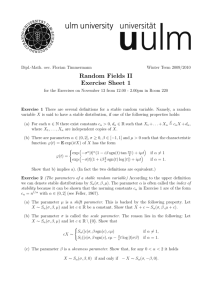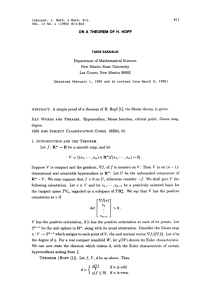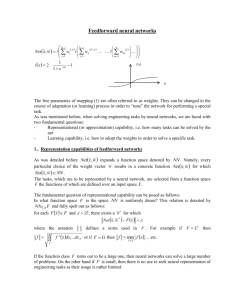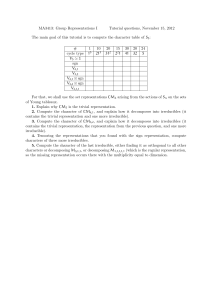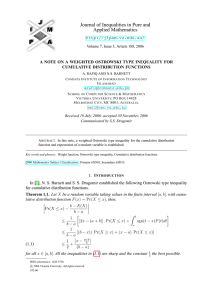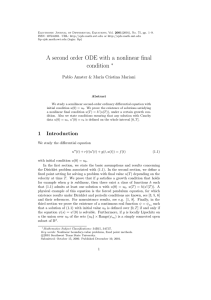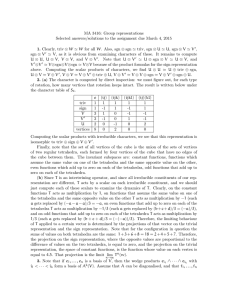The contracted model of exploded real numbers u ·
advertisement
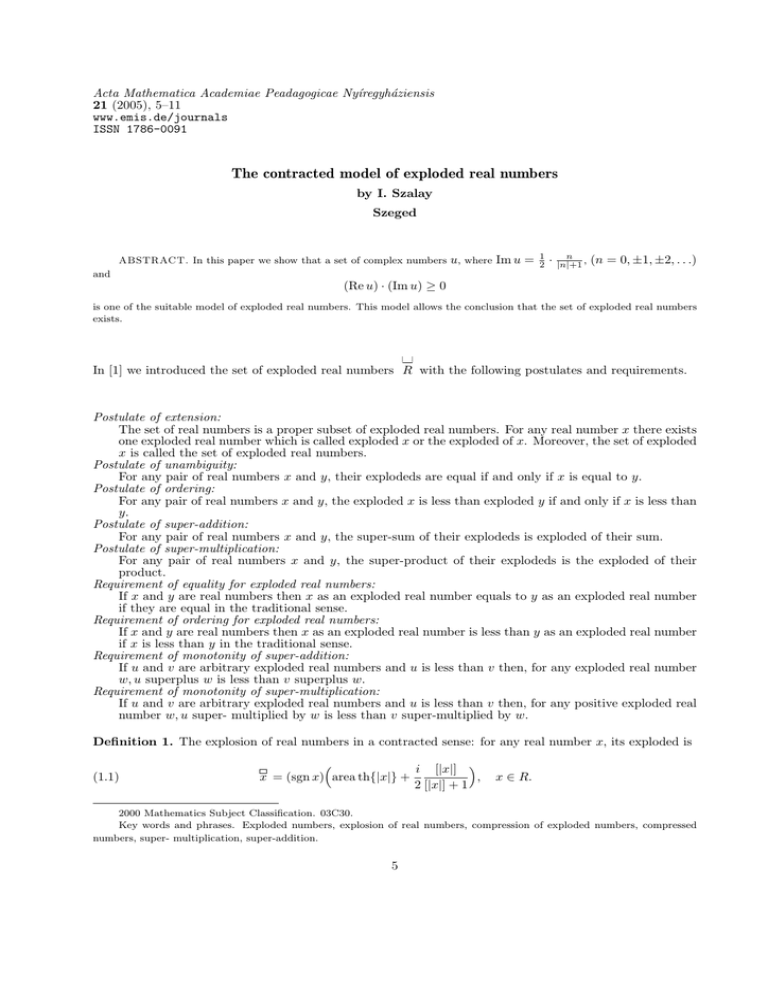
Acta Mathematica Academiae Peadagogicae Nyı́regyháziensis
21 (2005), 5–11
www.emis.de/journals
ISSN 1786-0091
The contracted model of exploded real numbers
by I. Szalay
Szeged
ABSTRACT. In this paper we show that a set of complex numbers
u, where Im u =
1
2
·
n
|n|+1 ,
(n = 0, ±1, ±2, . . .)
and
(Re u) · (Im u) ≥ 0
is one of the suitable model of exploded real numbers. This model allows the conclusion that the set of exploded real numbers
exists.
|
|
In [1] we introduced the set of exploded real numbers R with the following postulates and requirements.
Postulate of extension:
The set of real numbers is a proper subset of exploded real numbers. For any real number x there exists
one exploded real number which is called exploded x or the exploded of x. Moreover, the set of exploded
x is called the set of exploded real numbers.
Postulate of unambiguity:
For any pair of real numbers x and y, their explodeds are equal if and only if x is equal to y.
Postulate of ordering:
For any pair of real numbers x and y, the exploded x is less than exploded y if and only if x is less than
y.
Postulate of super-addition:
For any pair of real numbers x and y, the super-sum of their explodeds is exploded of their sum.
Postulate of super-multiplication:
For any pair of real numbers x and y, the super-product of their explodeds is the exploded of their
product.
Requirement of equality for exploded real numbers:
If x and y are real numbers then x as an exploded real number equals to y as an exploded real number
if they are equal in the traditional sense.
Requirement of ordering for exploded real numbers:
If x and y are real numbers then x as an exploded real number is less than y as an exploded real number
if x is less than y in the traditional sense.
Requirement of monotonity of super-addition:
If u and v are arbitrary exploded real numbers and u is less than v then, for any exploded real number
w, u superplus w is less than v superplus w.
Requirement of monotonity of super-multiplication:
If u and v are arbitrary exploded real numbers and u is less than v then, for any positive exploded real
number w, u super- multiplied by w is less than v super-multiplied by w.
Definition 1. The explosion of real numbers in a contracted sense: for any real number x, its exploded is
(1.1)
³
i [|x|] ´
,
x = (sgn x) area th{|x|} +
2 [|x|] + 1
x ∈ R.
2000 Mathematics Subject Classification. 03C30.
Key words and phrases. Exploded numbers, explosion of real numbers, compression of exploded numbers, compressed
numbers, super- multiplication, super-addition.
5
Clearly,
Im x =
1 n
,
2 |n| + 1
where n
is an integer number and (Re x ) · (Im x ) ≥ 0.
Theorem 2. The mapping x → x is mutually unambiguous.
Proof. Obviously, if x = y ⇒ x = y (Re x = Re y and Im x = Im y )
Conversely, we assume that x = y . Hence,
(2.1)
(sgn x) area th{|x|} = (sgn y) area th{|y|}
and
(2.2)
(sgn x)
[|x|]
[|y|]
= (sgn y)
.
[|x|] + 1
[|y|] + 1
By (2.2) the cases |x| ≥ 1 and |y| < 1; |x| < 1 and |y| ≥ 1 are not allowed so we have the following two cases
a)
0 ≤ |x|, |y| < 1
or
b)
|x|, |y| ≥ 1,
only.
In the case a) exception of x = y = 0, |x| < 1 and y = 0; x = 0 and |y| < 1 is not allowed. (See (2.1).)
Otherwise we can see that {|x|} and {|y|} are positive numbers, so (2.1) gives that sgn x = sgn y.
[|y|]
[|x|]
and [|y|]+1
are positive numbers so, (2.2) gives that sgn x = sgn y.
In the case b) we have that [|x|]+1
Collecting these, for all allowed cases of the pairs x, y we obtain
(2.3)
sgn x = sgn y.
Using (2.3) we can see that (2.2) yields
(2.4)
[|x|] = [|y|].
Using (2.3) again by (2.1) we get
(2.5)
{|x|} = {|y|}.
By (2.4) and (2.5) we have that |x| = |y| and finally (2.3) gives that x = y. ¥
Remark. Theorem 2 shows that the Postulate of unambiguity is fulfilled.
n
Theorem 3. If u is a complex number such that Im u = 21 |n|+1
, n = 0, ±1, ±2, . . . and (Re u) · (Im u) ≥ 0,
then
Im u
+ th Re u = u.
1
−| Im u|
2
Proof. It is easy to see that
(3.2)
1
2
Im u
=n
− | Im u|
is valid. First let be n = 1, 2, 3, . . .. Now we have that Re u ≥ 0 and by (1.1)
n + th Re u = area th(th Re u) +
6
i n
= Re u + i Im u = u.
2n+1
For n = 0, u is a real number, so Re u = u. Using (1.1) we have:
th u = (sgn u) area th{| th u|} = (sgn u) area th | th u| =
= (sgn u) area th(th |u|) = (sgn u)|u| = u.
Finally, for n = −1, −2, −3 we have that Re u ≤ 0 and by (1.1)
³
i |n| ´
= Re u + i Im u = u.
n + th Re u = − area th(− th Re u) +
2 |n| + 1
¥
Theorem 3 and (1.2) yield
Corollary 4. The complex number u is an exploded real number in a contracted sense, if and only if
n
, n = 0, ±1, ±2, . . ., and (Re u) · (Im u) ≥ 0.
Im u = 12 |n|+1
We denote the set of exploded real numbers, in a contracted sense, by R .
R = {u ∈ C : u = Re u + i Im u, Im u =
1 n
, n is integer and (Re u) · (Im u) ≥ 0.}
2 |n| + 1
Definition 5. For any set S ⊆ R, the exploded S is: S = {u ∈ C : u = x such that x ∈ S}. Considering
the open interval (−1, 1) by Definitions 1 and 5 we obtain
Corollary 6. (−1, 1) = R.
So, we can see that the Postulate of extension is fulfilled.
Definition 7. The compression of exploded real numbers: for any exploded real number u, its compressed
is
(7.1)
u =
1
2
Im u
+ th Re u,
− | Im u|
u ∈ R.
By (3.1) and (7.1) we have the identity
(7.2)
( u ) = u,
u ∈ R.
Definition 8. For set S ⊆ R , the compressed of S is: S = {x ∈ R : x = u , such that u ∈ S}.
Theorem 9. For any real number x the identity
(9.1)
( x ) = x,
x∈R
holds.
Definitions 5 and 8 with (7.2) and (9.1) yield
Corollary 10.
(10.1)
( S ) = S,
S⊆R
and
|
(10.2)
( S ) = S,
7
|
S ⊆ R.
R
Definition 11. For any x, y ∈ R we say that x < y if Im x < Im y or if Im x = Im y then Re x < Re y .
R
R
Definition 12. For any x, y ∈ R we say that x > y if y < x .
R
Theorem 13. For any x the inequality x < y holds if and only if x < y.
Proof.
R
Necessity. Let us assume that x < y . By Definition 11 we consider two cases:
Case 1. Im x < Im y , that is, by (1.1) we have
(13.1)
(sgn x)
[|y|]
[|x|]
< (sgn y)
[|x|] + 1
[|y|] + 1
[|x|]
Now, if x ≥ y then considering the monotonity of the function f (x) = (sgn x) [|x|]+1
we have that f (x) ≥ f (y)
which contradicts (13.1). So, x < y.
Case 2. Im x = Im y and Re x < Re y . Now we have (2.2) and
(13.2)
(sgn x) area th{|x|} < (sgn y) area th{|y|}
moreover, x and y are not integer numbers. If x = 0 then y > 0, if y = 0 then x < 0. Otherwise, area th{|x|},
area th{|y|} > 0. Inequality sgn x > sgn y is not allowed.
If sgn x < sgn y then x < y, obviously.
If sgn x = sgn y = 1, then (2.2) yields that [x] = [y] and (13.2) gives that {x} < {y}, so 0 < x < y.
If sgn x = sgn y = −1, then (2.2) yields that [|x|] = [|y|] and the identity [|x|] = −([x] + 1) shows that
[x] = [y]. Inequality (13.2) gives that {|x|} > {|y|}. Hence, by identity {|x|} = −({x} − 1) we have that
{x} < {y}. So, x < y < 0 is obtained.
Collecting the cases we have
(13.3)
x < y.
[|x|]
Sufficiency. Let us assume that x < y. Considering the monotonity of the function f (x) = (sgn x) [|x|]+1
,
we have
(13.4)
(sgn x)
[|x|]
[|y|]
< (sgn y)
[|x|] + 1
[|y|] + 1
or
(13.5)
(sgn x)
[|x|]
[|y|]
= (sgn y)
.
[|x|] + 1
[|y|] + 1
R
In case of (13.4), Definition 11 and (1.1) show that x < y .
In case of (13.5) the cases |x| ≥ 1 and |y| < 1; |x| < 1 and |y| ≥ 1 are not allowed. So, we have the following
two cases
a)
0 ≤ |x|, |y| < 1
or
b)
|x|, |y| ≥ 1,
only.
8
In the case a) if x = 0 then y > 0, if y = 0 then x < 0. Otherwise, 0 < |x|, |y| < 1. Clearly,
[|x|] = [|y|] = 0, so {|x|} = |x|, {|y|} = |y|. The inequality x < y implies that sgn x ≤ sgn y.
If sgn x < sgn y then −1 < x < 0 < y < 1. So,
(sgn x) area th{|x|} < 0 < (sgn x) area th{|y|}
and Definition 11 by (1.1) gives that x < y .
If sgn x = sgn y = 1 then 0 < x < y < 1. So,
0 < (sgn x) area th{|x|} < (sgn y) area th{|y|}
and Definition 11 by (1.1) gives that x < y .
If sgn x = sgn y = −1, then −1 < x < y < 0. Hence, 0 < |y| < |x| < 1 and 0 < {|y|} < {|x|} < 1. So
0 > (sgn y) area th{|y|} > (sgn x) area th{|x|} > −1
and Definition 11 by (1.1) gives that x < y .
In the case b) (13.5) yields
[|x|] = [|y|].
Integer x and y are not allowed.
If sgn x = sgn y = 1, then the identity {|x|} = x − [|x|] by x < y implies that {|x|} < {|y|}. Hence,
(sgn x) area th{|x|} < (sgn y)(area th{|y|}). So, Definition 11 by (1.1) gives that x < y .
The case sgn x = 1 and sgn y = −1 is not allowed.
If sgn x = −1 and sgn y = 1 then (sgn x) area th{|x|} < (sgn y)(area th{|y|}). So Definition 11 by (1.1)
gives that x < y .
If sgn x = sgn y = −1, then identity {|x|} = −x − [|x|]. So, inequality x < y implies −x > −y > 1.
Hence, {|x|} > {|y|}. So, (sgn x) area th{|x|} < (sgn y) area th{|y|} and Definition 11 by (1.1) gives that x
< y.
Remark. Theorem 13 shows that the Postulate of ordering is fulfilled.
R
Theorem 14. If x, y ∈ R then x < y ⇐⇒ x < y.
R
Proof. Identity (7.2) and Theorem 13 show that x < y ⇐⇒ x < y . By (7.1) we have that x = th x and
y = th y. Using the strict monotonity of the function th we have that x < y ⇐⇒ x < y.
Remark. Theorem 14 shows that the Requirement of ordering is fulfilled.
R
Remark 15. By Theorem 14 we may use u < v instead of u < v for any u, v ∈ R . Theorem 13 with
identity (7.2) gives
Theorem 16. (Monotonity of compression) For any u, v ∈ R the inequality u < v holds if and only if
u < v. Moreover, Theorem 13 yields the following corollaries:
Corollary 17. The relation ”<” is irreflixive, anti- symmetrical and transitive.
Corollary 18. (Trichotomity)) For any x, y ∈ R from among relations x < y , x = y and x > y one
and only one is true.
Definition 19. (Super-addition) For any x, y ∈ R, the super-sum of x and y is
(19.1)
³
\/
i [|x + y|] ´
.
+ y = (sgn(x + y)) area th{|x + y|} +
x −°−
/\
2 [|x + y|] + 1
9
By Definition 1 the identity
(19.2)
\/
+ y = x+y,
x −°−
/\
x, y ∈ R (See P ostulate of super − addition)
is obvious.
Definition 20. (Super-multiplication) For any x, y ∈ R, the super-multiplication of x and y is
\/
(20.1)
· y = (sgn(x · y))(area th{|x · y|} +
x −°−
/\
i [|x · y|]
.
2 [|x · y|] + 1
By Definition 1 the identity
(20.2)
\/
· y = x·y,
x −°−
/\
x, y ∈ R (See P ostulate of super − multiplication)
is obvious.
Remark 21. Using identities (19.2) and (20.2) we find that the field (R, +, ·) is isomorphic with the
\/
\/
algebraic structure ( R , −°−
+ , −°−
· ); so the latter is also a field with the operations super-addition and
/\
/\
super-multiplication. By (19.1) we can see that the additive unit element of R is 0 = 0. The additive
inverse element of x is −x for which, by (1.1), the identity
−x = − x ,
(21.1)
x∈R
holds. By (20.1) we can see that the multiplicative unit element of R is 1 = 4i . The multiplicative inverse
element of x 6= 0 is ( 1 ) .
x
Remark 22. By (7.1) we have that for any u ∈ R the identity
(22.1)
− u = −u,
u∈ R
holds. Moreover, denoting x = u and y = v, the identities (19.2) and (20.2) by (9.1) yield the identities
\/
u −°−
+ v = u + v (u, v ∈ R )
/\
(22.2)
and
\/
u −°−
· v = u · v (u, v ∈ R ),
/\
(22.3)
respectively.
Definition 23. The exploded real number u is called positive if u > 0 and negative if u < 0. (These are
extensions of the familiar positivity and negativity of real numbers.)
Theorem 24. (Monotonity of super-addition) Let u, v and w be arbitrary exploded real numbers. If u < v
then
\/
\/
u −°−
· w < v −°−
+ w.
/\
/\
Proof. Using (22.2), Theorem 16, Theorem 13 and (22.2) again, we have that
\/
\/
u −°−
+ w = u + w < v + w = v −°−
+ w.
/\
/\
10
Theorem 25. (Monotonity of super-multiplication) Let u, v be arbitrary and w positive exploded real
\/
\/
/\
/\
numbers. If u < v then u −°−
· w < v −°−
· w.
Proof. First, we mention that by Theorem 16 and Definition 23 with Definition (7.1) w > 0 = 0 is
obtained. Moreover, using (22.3), Theorem 16, Theorem 13 and (22.3) again, we have that
\/
\/
u −°−
· w = u · w < v · w = v −°−
· w.
/\
/\
|
|
\/
\/
/\
/\
· ) is an
+ , −°−
Remark 26. Considering Remark 21, Theorem 24 and Theorem 25 we can see that ( R , −°−
ordered field.
Reference
[1] I. Szalay: Exploded and compressed numbers. AMAPN, 18(2):33-51, 2002.
Received October 27, 2003.
DEPARTMENT OF MATHEMATICS
FACULTY OF TEACHER’S TRAINING
UNIVERSITY OF SZEGED
H-6720 SZEGED, BOLDOGASSZONY SGT, 6-8.
E-mail adress: szalay@jgytf.u-szeged.hu
11



